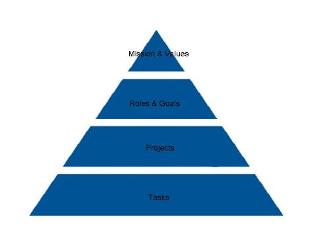| |
GTD Overview
There's a reason Getting Things Done (aka GTD) has become one of the
most popular and often used time management systems: it's
incredibly
powerful AND simple. Put simply, it's a bottom
up time
management
system, meaning its primary focus is on actions and projects.
The advantage of using a
bottom-up system is in
dealing with the daily tasks that come your way:

Bottom-up systems focus on specifically what you need to do.
The
starting point is your actions and projects, with little - or at least
less - focus put on the higher levels of your mission, values, roles,
goals, etc.
- Buy dog food
- Buy cell phone for daughter
- Wash and fold laundry
- Prepare for meeting with CFO
- Review draft of 2008 Tax Return
- Drop off daughter at gymnastics
- Drop off son at soccer practice
- Create training plan for running group
- Run 6 miles in target heart zone
- Pick up daughter from gymnastics
- Pick up son from soccer practice
Bottom-up systems are great at capturing all of these daily
to-do's and more.
GTD is so powerful because of its basic premises.
To be
effective, you've got to:
- Get things out of your head and into a trusted
system
- Make Up front decisions about your next actions
First, a quick note about using any time management system...
Time Management is a Thinking Process
It doesn't matter whether you use paper and pencil, a planner, a
Blackberry, Palm or other smartphone, or what computer system you're
on. Although the tools certainly help, once you get the concepts and
principles, you can be just as
effective with
whatever resources you may have.
Change is
constant - principles are not.
Keep that in mind as you're learning the GTD and RPM systems.
Getting Things Done takes the Write
Everything Down time management technique to a whole nother
level by integrating it into a complete system.
It's
generally agreed that we're capable of focusing on 7 things - plus or
minus two - at any given time. We can't be effective when our focus is
on trying to remember all of the things we think we have to do.
This system solves the problem through mastering 5 workflow steps:
- Collecting
- Processing
- Organizing
- Reviewing
- Doing
The above workflow pages summarize each step, including a
fantastic flowchart
David Allen created for the processing and organizing steps.
Additionally, I share my setup, not for you to
copy – although you certainly can if you like – but to give you some
ideas for what may work best for you.
Want access
to subscriber only content and
the latest time management tips, techniques, and strategies? Sign up
for the free monthly Time Management Times newsletter here:
Make sure
you don't miss any new content. Subscribe to the Time
Management Blog rss feed, a time management technique all
it's own. What better way to get the information you want then by
having it come to you...
Subscribe now either by clicking on one of the "Subscribe To This Site"
buttons to the left, or go the the Time
Management Blog page for more information.


|



